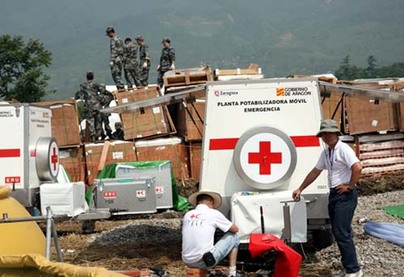How have things gone in terms of cooperation with local governments?
Extremely well; we have had very good cooperation and support and the level of interest has been very high. The level of support from the RCSC has also been very high. We believe that during this crisis we are seeing something very new and significant in China's experience of the Red Cross movement.

One of several mobile drinking water plants being installed in Jiulong by a team from the Spanish Red Cross, June 9, 2008. In the foreground is Wei Gang, the team’s volunteer translator. In normal times he is a maths professor at Shandong University.
After some time, the Emergency Response Units will be handed over to the Chinese Red Cross. Each ERU team has a Chinese counterpart learning the ropes and how to operate the equipment. They will take over after a few weeks. This also applies to the German Field Hospital we set up in Dujiangyan.
The RCSC is very interested in the ERUs, because there is a feeling that at some point in the future, the RCSC is going to play a much more pro-active role as a giver of assistance to other countries, so the RCSC is interested in exploring setting up its own ERUs.
Can you tell us more about the Red Cross Society of China?
The RCSC was set up in 1904 and it is commonly tagged the oldest NGO in China. After 1949 it was subsumed under the umbrella of the Ministry of Health but since 1994 there has been a process of separation. The separation is complete at the national, provincial and city levels, but at the township level you still find people wearing both government and Red Cross hats. It has been a momentous process and has opened up many new opportunities and avenues for the RCSC.
The present disaster has projected the RCSC into a much more important and prominent role than it has ever played before and we are seeing a whole new phase in its evolution.
What numbers and capabilities has the Chinese Red Cross been able to mobilize?
For this earthquake we've had more than 35,000 RCSC staffers and volunteers involved.
Are most skilled in medicine or other specialties?
Not necessarily. There have been medical teams from all over China but also volunteers from all walks of life. In the early days after the earthquake, the courtyard of the Sichuan Provincial Red Cross was packed with people prepared to do all sorts of things, such as carrying food and water supplies, disinfecting areas and so on.
How effective have the volunteers been?